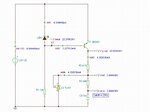HasHx
Member level 4
It neither works as a voltage reference if connected this way. Presently R3, D5, Q1 are useless and can be replaced by a wire powering the reference.
I really hate reverse engineering, you never know what the designer was thinking... I am afraid if i remove them i'd miss something
